-
Membership
Membership
Anyone with an interest in the history of the built environment is welcome to join the Society of Architectural Historians -
Conferences
Conferences
SAH Annual International Conferences bring members together for scholarly exchange and networking -
Publications
Publications
Through print and digital publications, SAH documents the history of the built environment and disseminates scholarship -
Programs
Programs
SAH promotes meaningful engagement with the history of the built environment through its programsMember Programs
-
Jobs & Opportunities
Jobs & Opportunities
SAH provides resources, fellowships, and grants to help further your career and professional life -
Support
Support
We invite you to support the educational mission of SAH by making a gift, becoming a member, or volunteering -
About
About
SAH promotes the study, interpretation, and conservation of the built environment worldwide for the benefit of all
SAH/Mellon Author Award-Winning Books Now Available
Nov 7, 2016
by
SAH News
SAH is happy to announce that five of the book projects funded by the SAH/Mellon Author Awards, which the society has administered since 2013, have been published to date. The awards are designed to provide financial relief to scholars who are publishing their first monograph on the history of the built environment, and who are responsible for paying for rights and permissions for images or for commissioning maps, charts or line drawings in their publications.
The following award-winning books are now available:
SAH is grateful to the Andrew W. Mellon Foundation for supporting this award.

The following award-winning books are now available:
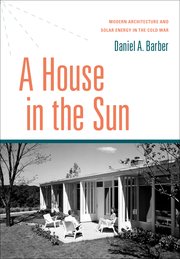 | 2014 WinnerA House in the Sun: Modern Architecture and Solar Energy in the Cold WarAuthor: Daniel A. BarberPublisher: Oxford University Press Published: November 2016 IBSN: 9780199394012 Discount Code: Use code AAFLYG6 when ordering through Oxford University Press to receive a 30% discount. From the publisher: A House in the Sun describes a number of experiments in solar house heating in American architectural, engineering, political, economic, and corporate contexts from the beginning of World War II until the late 1950s. Houses were built across the Midwest, Northeast, and Southwestern United States, and also proposed for sites in India, South Africa, and Morocco. These experiments developed in parallel to transformations in the discussion of modern architecture, relying on new materials and design ideas for both energy efficiency and claims to cultural relevance. Architects were among the myriad cultural and scientific actors to see the solar house as an important designed element of the American future. These experiments also developed as part of a wider analysis of the globe as an interconnected geophysical system. Perceived resource limitations in the immediate postwar period led to new understandings of the relationship between energy, technology and economy. The solar house - both as a charged object in the milieu of suburban expansion, and as a means to raise the standard of living in developing economies - became an important site for social, technological, and design experimentation. This led to new forms of expertise in architecture and other professions. Daniel Barber argues that this mid-century interest in solar energy was one of the first episodes in which resource limitations were seen as an opportunity for design to attain new relevance for potential social and cultural transformations. Furthermore, the solar discussion established both an intellectual framework and a funding structure for the articulation of and response to global environmental concerns in subsequent decades. In presenting evidence of resource tensions at the beginning of the Cold War, the book offers a new perspective on the histories of architecture, technology, and environmentalism, one more fully entangled with the often competing dynamics of geopolitical and geophysical pressures. Daniel A. Barber is an Assistant Professor of Architecture at the University of Pennsylvania, where he teaches in the School of Arts and Sciences and the School of Design, and an Alexander von Humboldt Research Fellow at the Rachel Carson Center for Environment and Society. |
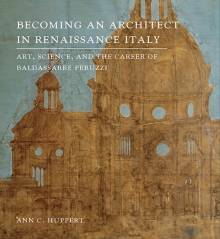 | 2014 WinnerBecoming an Architect in Renaissance Italy: Art, Science, and the Career of Baldassarre PeruzziAuthor: Ann C. HuppertPublisher: Yale University Press Published: June 2015 IBSN: 9780300203950 Discount Code: 25% off with the code YP014 when purchased at yalebooks.com or by phone at 1-800-405-1619 From the publisher: A leading architect of the Italian Renaissance, Baldassarre Peruzzi (1481–1536) has, until now, been a little-known, enigmatic figure. A paucity of biographical documentation and a modest number of surviving buildings, coupled with an undeservedly critical assessment by Giorgio Vasari (1511–1574), have long cast Peruzzi’s career in shadow. With Becoming an Architect in Renaissance Italy, Ann C. Huppert taps into a known, but neglected resource—Peruzzi’s autograph drawings—and reveals the full scope and artistic mastery of Peruzzi’s work and its enduring influence. Extraordinary not only in their beauty and design inventiveness, but also in the varied representational techniques and practical mathematics noted within them, Peruzzi’s drawings record an evolving artistic process. Reassessing his architectural masterworks, Huppert also explores lesser-known work: his studies of Roman antiquity, realized paintings and unrealized buildings, as well as engineering projects. Huppert shows that Peruzzi anticipated modern representational methods and scientific approaches in architecture, and pinpoints the moment when architecture began to emerge as a profession distinct from the other arts. Ann C. Huppert is associate professor of architectural history in the Department of Architecture at the University of Washington in Seattle. |
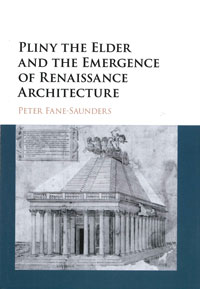 | 2014 Winner Pliny the Elder and the Emergence of Renaissance ArchitectureAuthor: Peter Fane-SaundersPublisher: Cambridge University Press Published: July 2016 IBSN: 9781107079861 Discount Code: 20% off with code SAUNDERS2016 (expires April 25, 2017) From the publisher: The Naturalis historia by Pliny the Elder provided Renaissance scholars, artists and architects with details of ancient architectural practice and long-lost architectural wonders – material that was often unavailable elsewhere in classical literature. Pliny's descriptions frequently included the dimensions of these buildings, as well as details of their unusual construction materials and ornament. This book describes, for the first time, how the passages were interpreted from around 1430 to 1580, that is, from Alberti to Palladio. Chapters are arranged chronologically within three interrelated sections – antiquarianism; architectural writings; drawings and built monuments – thereby making it possible for the reader to follow the changing attitudes to Pliny over the period. The resulting study establishes the Naturalis historia as the single most important literary source after Vitruvius's De architectura. Peter Fane-Saunders is a specialist in the history of art and architecture. His main research interest is the classical tradition – particularly those aspects of the visual arts that derive their inspiration from the ancient world. He received his doctorate from the Warburg Institute, London. His articles have been published in various academic journals. He was Rome Fellow at the British School at Rome and currently holds a Leverhulme Trust Early Career Fellowship at the University of Durham. |
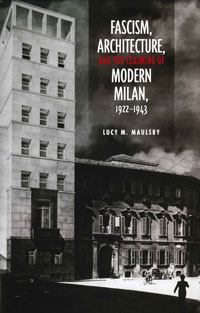 | 2013 Winner Fascism, Architecture, and the Claiming of Modern Milan, 1922-1943Author: Lucy M. MaulsbyPublisher: University of Toronto Press Published: 2014 IBSN: 9781442646254 Discount: 25% off when you order online From the publisher: Fascism, Architecture, and the Claiming of Modern Milan, 1922–1943 chronicles the dramatic architectural and urban transformation of Milan during the nearly twenty years of fascist rule. The commercial and financial centre of Italy and the birthplace of fascism, Milan played a central role in constructing fascism’s national image and identity as it advanced from a revolutionary movement to an established state power. Using a wide range of archival sources, Lucy M. Maulsby analyses the public buildings, from the relatively modest party headquarters to the grandiose Palace of Justice and the Palazzo del Popolo d’Italia, through which Mussolini intended to enhance the city’s image and solidify fascism’s presence in Milan. Maulsby establishes the extent to which Milan’s economic structure, social composition, and cultural orientation affected Il Duce’s plans for the city, demonstrating the influences on urban development that were beyond the control of the fascist regime. By placing Milan’s urban change in its historic context, this book expands our understanding of the relationship between fascism and the modern city. Lucy M. Maulsby is an assistant professor in the School of Architecture at Northeastern University in Boston. |
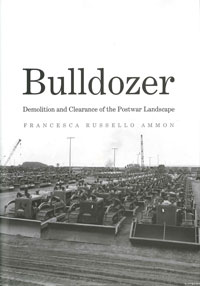 | 2013 Winner Bulldozer: Demolition and Clearance of the Postwar LandscapeAuthor: Francesca Russello AmmonPublisher: Yale University Press Published: April 2016 IBSN: 9780300200683 Discount code: 25% off with the code YZ709 when purchased at yalebooks.com or by phone at 1-800-405-1619 From the publisher: Although the decades following World War II stand out as an era of rapid growth and construction in the United States, those years were equally significant for large-scale destruction. In order to clear space for new suburban tract housing, an ambitious system of interstate highways, and extensive urban renewal development, wrecking companies demolished buildings while earthmoving contractors leveled land at an unprecedented pace and scale. In this pioneering history, Francesca Russello Ammon explores how postwar America came to equate this destruction with progress. The bulldozer functioned as both the means and the metaphor for this work. As the machine transformed from a wartime weapon into an instrument of postwar planning, it helped realize a landscape-altering “culture of clearance.” In the hands of the military, planners, politicians, engineers, construction workers, and even children’s book authors, the bulldozer became an American icon. Yet social and environmental injustices emerged as clearance projects continued unabated. This awareness spurred environmental, preservationist, and citizen participation efforts that have helped to slow, though not entirely stop, the momentum of the postwar bulldozer. Francesca Russello Ammon is assistant professor of city and regional planning and historic preservation at the University of Pennsylvania. She studies the history of the built environment, focusing on the social, material, and cultural life of cities in the twentieth-century United States. She lives in Philadelphia, PA. |
SAH is grateful to the Andrew W. Mellon Foundation for supporting this award.



